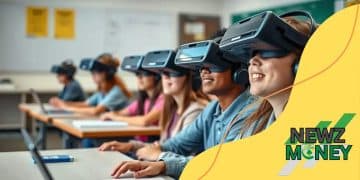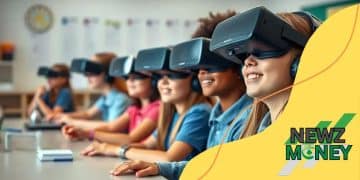AI tools for special education and inclusive classrooms

AI tools for special education and inclusive classrooms enhance learning by personalizing experiences, improving engagement, and providing necessary support for diverse learners, fostering an environment where all students can succeed.
AI tools for special education and inclusive classrooms are reshaping the educational landscape. Imagine a classroom where every student, regardless of ability, can thrive. Curious about how these technologies work? Let’s dive in!
understanding AI tools for education
Understanding AI tools for education is essential for creating inclusive learning environments. These tools can offer personalized support, making lessons more engaging for students with diverse needs.
What are AI tools?
AI tools are technologies that use artificial intelligence to assist in learning. They can adapt to individual students, providing customized resources and feedback. This means every student can learn at their own pace.
- Adaptive learning platforms adjust to student performance.
- Speech recognition software helps students with reading challenges.
- Virtual reality can create immersive learning experiences.
- Data analytics can track student progress effectively.
Moreover, these tools often come with user-friendly interfaces, making them accessible even for younger students. When teachers integrate AI resources into their classrooms, they open up new avenues for collaboration and creativity.
Benefits of understanding AI tools
Having a solid grasp of AI tools enables educators to enhance their teaching methods. For instance, they can quickly identify those who may need extra support. This proactive approach helps improve overall classroom dynamics.
Besides academic growth, students using AI tools often show increased motivation. They experience learning as a personalized journey, which can lead to higher confidence levels.
benefits of AI in special education
Exploring the benefits of AI in special education reveals how technology can transform learning experiences for students with unique needs. These tools help to address various challenges and create more effective learning environments.
Personalized Learning
One of the biggest advantages is the ability to offer personalized learning experiences. AI can assess a student’s strengths and weaknesses and adapt lessons accordingly. This ensures that every learner receives the support they need.
- Tailored instruction that meets individual learning styles.
- Continuous feedback that helps track progress.
- Engaging content that keeps students interested.
- Flexible pacing, allowing students to learn at their own speed.
In addition to personalized learning, AI tools often provide interactive features. For example, games and simulations can make learning more enjoyable and relevant. These engaging experiences promote deeper understanding and retention of material.
Enhanced Communication
AI also boosts communication between teachers and students. Tools like text-to-speech can assist students who struggle with reading, while speech recognition can help them express their thoughts effectively. This increase in communication fosters a more inclusive classroom atmosphere.
Besides supporting speech and language development, AI can facilitate collaboration among students. Technology allows for group projects that accommodate different abilities. This collaboration strengthens the sense of community in the classroom.
how to implement AI in inclusive classrooms

Learning how to implement AI in inclusive classrooms can be a game changer for educators. It involves understanding how technology can support all students, enabling them to thrive in their educational journeys.
Identify Needs
Before introducing AI tools, it’s essential to identify the specific needs of your students. Each classroom consists of diverse learners, each with unique challenges and strengths. By assessing these needs, teachers can choose the most suitable AI solutions.
- Recognize students who may need extra support.
- Assess the learning styles of different students.
- Determine which subjects or skills require additional resources.
- Involve parents and specialists in the assessment process.
Once needs are identified, the next step is to select the right tools. There are various AI-driven platforms designed to assist in special education. Selecting the most appropriate technology can significantly impact students’ learning experiences.
Training for Educators
Training teachers to effectively use AI tools is vital. Professional development sessions should focus on how to integrate these technologies into lessons seamlessly. Ongoing support ensures that educators feel confident in their ability to use AI resources.
Sharing experiences among teachers can also enhance the overall implementation process. Collaborating in professional learning communities allows educators to exchange tips and strategies for using AI successfully.
real-life examples of AI improving learning
Real-life examples of AI improving learning highlight how technology can reshape educational experiences. Many schools and educators are successfully integrating AI tools to enhance students’ learning outcomes.
Personalized Learning Platforms
One effective application of AI is through personalized learning platforms. These platforms adapt to individual students’ progress and provide tailored recommendations. For instance, a platform might suggest additional exercises for a student struggling with math concepts, allowing them to practice at their own pace.
- A well-known platform, DreamBox Learning, adjusts lessons based on student interactions.
- Gradescope uses AI to help educators grade assignments more efficiently, enabling more personalized feedback.
- Read&Write provides tools like text-to-speech and word prediction to support diverse learners.
These technologies not only assist in knowledge retention but also boost student confidence, making learning more enjoyable.
AI in Special Education
AI has also shown great promise in special education settings. Tools like speech recognition assist students with communication challenges. For example, Voiceitt helps individuals with speech impairments communicate more easily, enabling their participation in classroom discussions.
Additionally, AI-driven analytics can track student performance over time. Teachers can identify patterns and make informed decisions based on the data, leading to improved teaching strategies and better student support.
future trends in AI for education
Future trends in AI for education promise to revolutionize how we teach and learn. As technology advances, AI tools will become even more integral in creating personalized and engaging educational experiences.
Adaptive Learning Systems
Adaptive learning systems are expected to dominate the educational landscape. These systems leverage AI to customize the learning process based on individual student needs. By analyzing performance in real time, they can modify lessons to suit each learner’s pace and style.
- Students will receive tailored resources that directly address their strengths and weaknesses.
- Teachers can focus on guiding students rather than spending time on rote grading.
- Data analytics will help educators identify trends and gaps in understanding.
This approach not only enhances learning outcomes but also fosters a sense of agency among students.
Integration of Virtual Reality
Another emerging trend is the integration of virtual reality (VR) in education. AI-driven VR experiences can transport students to different environments, making learning immersive and interactive. Imagine exploring ancient civilizations or conducting virtual science experiments without leaving the classroom.
This technology encourages active participation and can cater to various learning styles. Visual learners benefit from seeing concepts in 3D, while kinesthetic learners engage through hands-on experiences.
Enhanced Accessibility Features
The future of AI in education will also emphasize accessibility. Innovations are being developed to support students with disabilities. AI tools can provide speech-to-text services, real-time translation, and personalized learning aids.
Such features ensure that all students, regardless of their challenges, have equal opportunities to succeed. The push toward inclusive education will continue to drive the development of these essential tools.
The future of AI in education is bright and full of potential. As we integrate more advanced technologies, classrooms will become places where every student can thrive. AI tools will help tailor learning experiences, making them more accessible and engaging. By implementing these innovations, we can provide personalized support for all learners, and foster a sense of inclusivity. As we embrace these changes, our education systems will evolve, ensuring that every student has the opportunity to succeed.
FAQ – Frequently Asked Questions about AI in Education
What are the main benefits of using AI in education?
AI offers personalized learning experiences, improved engagement, and supports diverse learning needs, making education more accessible for all students.
How can AI tools help students with disabilities?
AI tools can provide speech recognition, text-to-speech functionalities, and adaptive learning resources, helping to enhance communication and learning for students with disabilities.
What role does data play in AI-enhanced learning?
Data analysis allows educators to track student progress, identify learning gaps, and fine-tune teaching strategies for better outcomes.
How can teachers prepare to implement AI in their classrooms?
Teachers can participate in training sessions, collaborate with peers, and explore various AI tools that suit their classroom needs to ensure a smooth integration.





